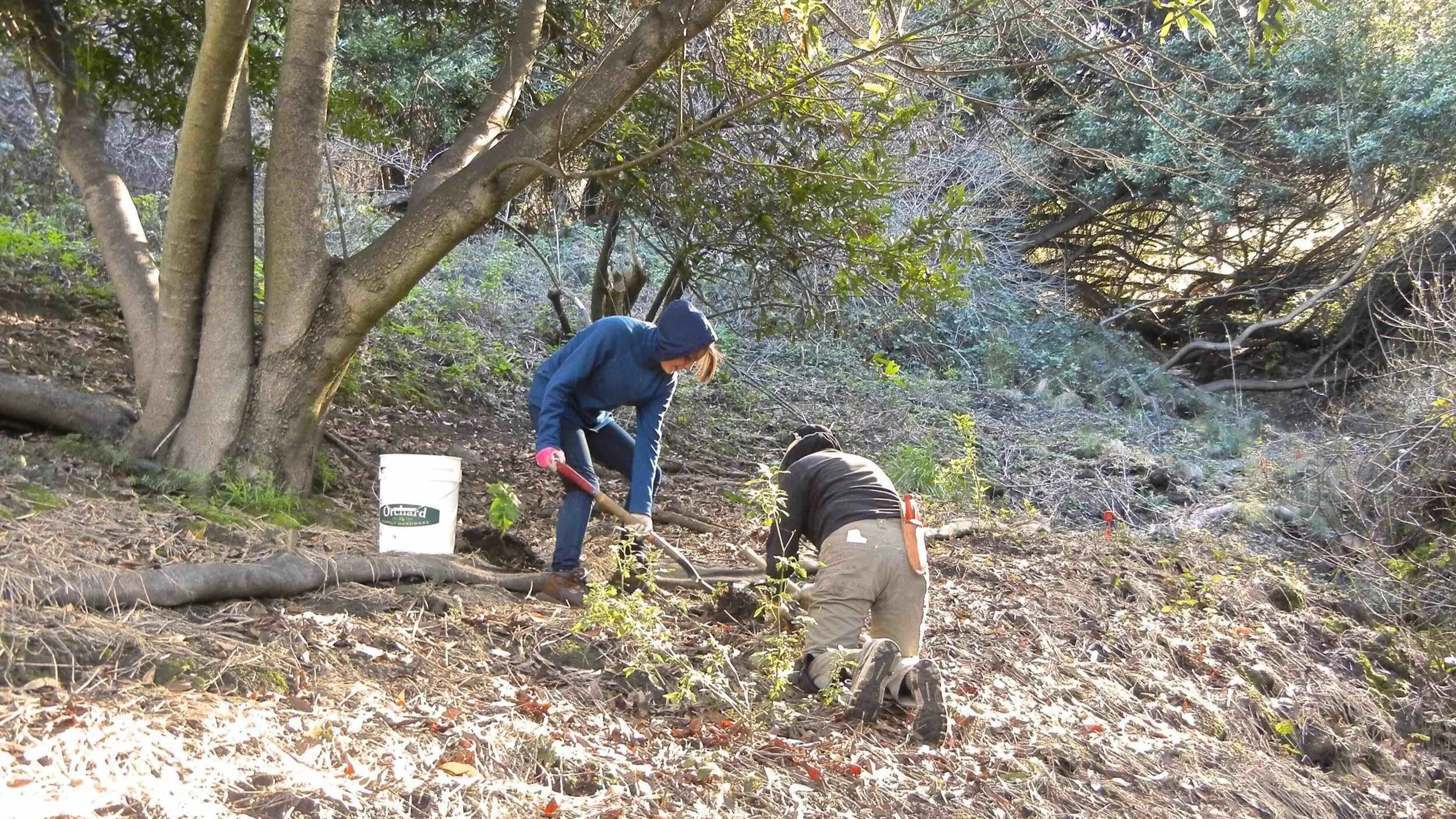On June 6, 2016, at Hiller Highlands Country Club, the Conservancy hosted the premier screening of the film “Bring Back the Oaks: Managing vegetation to reduce fire risk in the East Bay Hills.” Inspired by the controversy surrounding the FEMA grants for wildfire hazard mitigation, and in an effort to address public concerns, the making of the film was co-sponsored by the Sierra Club and the Conservancy, with a grant from the Sustainability, Parks, Recycling and Wildlife Legal Defense Fund.
Alameda whipsnake/striped racer research project, by Jessica Sheppard
Claremont Canyon Regional Preserve is hosting a research project focused on the Alameda whipsnake (Masticophis lateralis euryxanthus), also sometimes referred to as the Alameda striped racer (Coluber lateralis euryxanthus). This elusive and speedy snake is protected at the state and federal level and may be found in the park.
Art installation features view from Claremont Canyon, by Marilyn Goldhaber
Spring in the canyon and update on fire safety work, by L. Tim Wallace
Bring Back the Oaks, by Jim Hanson
Trails in the canyon, by Joe Engbeck
Panoramic Ridge Trail: The most popular trail in Claremont Canyon is the Stonewall-Panoramic Ridge Trail, sometimes called the East/West Trail at its upper end. The trail begins at the Stonewall Road entrance to Claremont Canyon Regional Preserve and climbs steeply for about a half-mile, enabling hikers to enjoy spectacular vistas of almost the entire San Francisco Bay Region.
An Invitation to burn, by Tamia Marg
The Claremont Canyon landscape and its uses have changed dramatically over the last century. From the 1800's through the first few decades of the 20th century, the East Bay hills were primarily grasslands with trees and brush growing only in canyon draws. Much of Gwin Canyon, a tributary on the south side of Claremont Canyon, was planted with Monterey Pines (Pinus radiata), a widely established practice in the hills to beautify the land for housing developments in the early Twentieth Century. That these trees were fast-growing tinder in the landscape became evident after every subsequent hill wildfire.
Eagle scout troop continues trail building, by Jon Kaufman
Conservancy letter supports UC's fire plan addendum, by Jon Kaufman
In response to a request for public comment, the Conservancy has written a detailed letter in support of the University's plan to implement its grant from FEMA to make the hills above our homes more fire safe. The plan is extremely detailed and addresses all the concerns that have been raised during the years long federal environmental review process
President's Message: Oakland steps up to the plate, by L. Tim Wallace
I can now say with confidence that all three FEMA-funded grants—Oakland’s, the Park District’s and UC’s—are set to move forward. Thanks to excellent media coverage, the public is now better informed about the need for wildfire prevention projects and better understands the responsibility that comes with providing a safer environment for all.
New trail maps installed in four places, by Fred Booker
The Sierra Club corrects its record on its vegetation management strategy for the East Bay hills
Reprinted from the online Yodeler, September 16, 2015, with permission from the San Francisco Bay Chapter of the Sierra Club. For a copy of their flyer prepared for members and the public, click here.
As we slog through our fourth year of drought and once again watch wildfires devastate communities all across California and the West, we must acknowledge that the hotter, drier conditions we face due to climate disruption are not going away.
The Sierra Club’s eucalyptus management policy is the right approach for East Bay hills, by John Hitchen
The Claremont Hotel’s sustainability group comes to Claremont Canyon, by Steve Holtzman
Since being acquired by Fairmont Hotels & Resorts in March 2014, the Claremont Hotel Club & Spa has stepped up its efforts to participate in conservation and stewardship activities in Claremont Canyon. Having long been the home of the Conservancy’s annual meetings, the Hotel, under the leadership of General Manager Len Czarnecki, has expanded its emphasis on sustainability.
Volunteers improve the experience of Claremont Canyon, by Jon Kaufman
The Berkeley Project Day, by Jon Kaufman
Creek-to-Bay Day in Garber Park, by Nancy Mueller
Just wanted to report two great projects last Saturday in our neighborhood: At the Demonstration Garden at Hiller and Old Tunnel, Gordon and Sue Piper led an enthusiastic group of volunteers. I had a chance to meet the new president of North Hills Community Association, Michael Schroeder (who was working his tail off!) and Carolyn Burgess, our terrific chair of Crime Prevention of NHCA.
Earth Day celebration in Garber Park, by Marilyn Goldhaber
If you happened to stop by Garber Park on the morning of April 18, you would have heard mentioned such mysterious-sounding places as Evergreen Hillside, Fern Glade and Horsetail Meadow. These are the beautiful mini-landscapes within Garber Park that are winter restoration sites for the Garber Park Stewards.
Park District Board accepts $4.65 m FEMA grant, press release from EBRPD
Reduce the fire hazard, don't litigate, by L. Tim Wallace
After 10 years, FEMA finally has issued its Record of Decision (ROD) on grants to reduce the fire danger posed by the eucalyptus trees in Claremont Canyon and the East Bay Hills. The ROD is not ideal. The Claremont Canyon Conservancy would have preferred the original draft that enabled the three grant applicants (UC Berkeley, the City of Oakland and the Regional Park District) to use the funds as each saw fit, rather than requiring all three grantees to use a “unified approach.”



